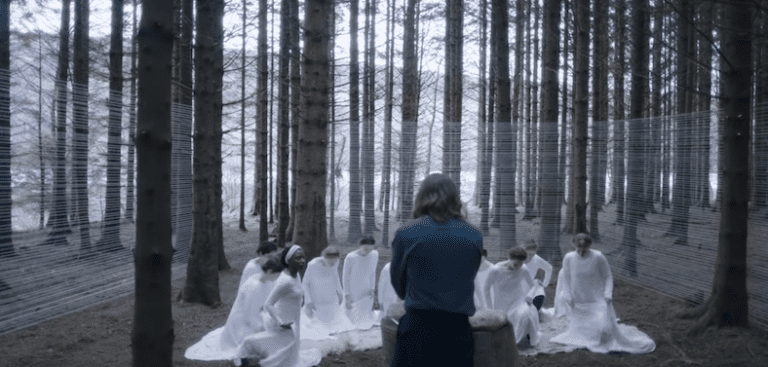
Our socialization plays a large part in forming who we are. What the culture we are immersed in tells us about ourselves and our characteristics matters in who we become. But as we grow older and see more of the world, we begin to question what we are taught. Even in the most extreme conditions. The Other Lamb is a story told from the perspective of Selah (Raffey Cassidy), a teenager born into a small cult comprised totally of women stationed in the wilderness, cut off from society, and led by a man who calls himself Shepherd (Michiel Huisman). Shepherd has separated his flock as he calls them into wives and daughters and exhibits complete control over them all. Soon, Selah begins to question Shepherd and the cult itself as Shepherd tightens his grip over her and the other women.
From The Other Lamb’s onset when we first meet the cult in their small forest compound, we see a web of threading that hangs overhead in one of the main cabins, as well as in the trees outside of it. This bit of visual storytelling is symbolic of the figurative, psychologically manipulative web that Shepherd has woven and entangled his female flock in; a web that is always hanging over them as the physical threading does. Shepherd has separated his flock into two distinct groups, the wives who generally skew older and the daughters who are younger and have lesser standing, but eventually catch the male leader’s lustful eye and ascend to matrimony, which then can lead to jealousy as the wives fear replacement at the hands of younger women. The dynamic touches on an obvious theme of patriarchal control and manipulation and its dangers to women for the film. Selah struggles with a growing sense of wrongness about her living condition and the treatment of the women around her, including her deceased mother, and her desire to please Shepherd. Her slow realization is edged along by a disillusioned wife quickly losing her standing named Sarah (Denise Gough) who explains to Selah that Shepherd’s attention is “Like the sun; glorious at first but then it just burns.” Thus explains the folly of bowing to the patriarchy, to men like Shepherd who couches his selfishness and cruelty in flowery religious rhetoric and pits women against each other for his own ends.
I was also struck by Szumowska’s use of blood to convey emotions and feelings such as pain or shame. Within the cult, Shepherd has deemed menstruation as unclean and ostracizes members of his flock during their cycles which has a clear psychological effect on Selah. This is displayed through the visual parallels drawn between her bleeding and rotten animals, alluding to a sense of degradation and lessened value for her as a result. The push for normalization of periods in western media has gained steam in recent years, from sanitary pad commercials using red liquid instead of the tradition blue to a blood emoji meant to lessen stigma for young girls. The depiction here of the menstruation cycle as a source for conflict and confusion with Selah as a result of the stigma placed upon it within her community fits within the film’s overarching theme about how society fails women; the mental manipulation that takes a natural bodily function and turns into a source of control.
The Other Lamb is a very esoteric and metaphorical film, filled to the brim by director Malgorzata Szumowska with symbolism, allegory, and other markers to provide topical commentary on women and their experiences in a world run by men. But the numerous gory scenes of rotting animals or of normal life for Selah interspersed with the isolated landscape of the cult can be confusing as to what’s reality and what is not, making one wonder if the film is too clever by half. Metaphor and abstraction are always welcomed as filmmaking and storytelling techniques, but walking that fine line between artistic choice and pretentiousness is difficult and one step too far in the wrong direction can take a film from bold to frustrating quickly. The film is a pleasure to look at, both in terms of the cinematographic choices and the production design, as well as Szumowska’s flair for visual storytelling; from the aforementioned symbolism and parallel visions of Selah to the contrast created between the red clothing of the wives to the blue clothing of the daughters, further cementing the division between the two within the cult. But despite its positive aspects, The Other Lamb cannot rise above its commitment to abstraction that ultimately takes away from its clarity and enjoyment factor.
Image: IFC Midnight

